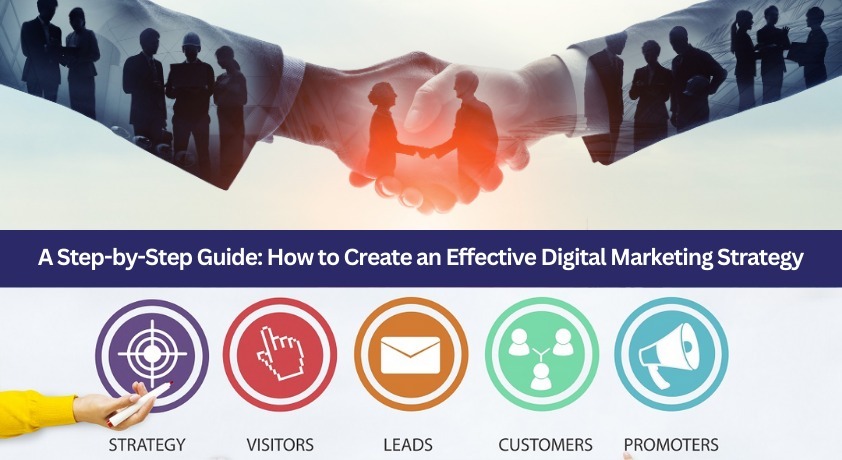
In today's digital age, a solid digital marketing strategy is crucial for businesses to thrive online. Whether a small startup or a well-established brand, an effective digital marketing strategy can help you attract and retain customers, increase brand awareness, and drive business growth.
But with the ever-evolving digital marketing landscape, creating a strategy that works can be daunting.
In this blog, we'll guide you through the essential steps to create a winning digital marketing strategy that aligns with your business goals and helps you stay ahead of the competition.
From defining your target audience and setting measurable goals to choosing the right digital channels and analyzing performance, we'll cover everything you need to know to create a successful digital marketing strategy that gets results.
So, let's dive in and unlock the power of digital marketing to take your business to new heights!
How to Create a Digital Marketing Strategy?
In today's digital world, having a well-defined digital marketing strategy is critical for businesses of all sizes.
A solid digital marketing strategy can help you reach your target audience, establish your brand, drive website traffic, generate leads, and ultimately boost sales and revenue.
This comprehensive guide will walk you through the essential steps to create an effective digital marketing strategy to help your business achieve its marketing goals.
Step 1: Define Your Objectives and Target Audience
The first and foremost step in creating a digital marketing strategy is clearly defining your marketing objectives. What do you want to achieve with your digital marketing efforts?
Are you looking to increase brand awareness, drive website traffic, generate leads, or boost sales? Having clear, measurable, and achievable objectives will guide your entire digital marketing strategy and help you stay focused.
Next, identify your target audience. Who are your ideal customers? What are their demographics, interests, and pain points?
Understanding your target audience is crucial for crafting relevant and personalized digital marketing campaigns that resonate with them.
Conduct market research, analyze customer data, and create buyer personas to gain insights into your target audience's preferences and behaviors.
Step 2: Choose the Right Digital Marketing Channels
Once you have defined your objectives and identified your target audience, the next step is to choose the right digital marketing channels to reach them. Various digital marketing channels are available, including search engine optimization (SEO), pay-per-click (PPC) advertising, social media marketing, content marketing, email marketing, and more.
Each channel has its strengths and weaknesses; the key is choosing the ones that align with your marketing objectives and target audience. For instance, if you want to improve your website's visibility on search engines and drive organic traffic, SEO should be a priority.
On the other hand, if you want to target a specific audience with immediate results, PPC advertising can be effective.
Social media marketing is great for building brand awareness and engaging with your audience, while content marketing can help you establish thought leadership and provide value to your target audience. Email marketing is ideal for nurturing leads and retaining customers.
It's important to carefully assess each channel's potential to reach your objectives and allocate your resources accordingly. Consider the budget, time, and expertise required to manage each channel effectively.
Step 3: Create Engaging and Relevant Content
Content is the backbone of any digital marketing strategy. It's what drives engagement, builds trust, and establishes your brand's authority. Creating high-quality, engaging, relevant content is crucial to attract and retain your target audience.
Start by conducting keyword research to identify the keywords and topics that are relevant to your business and your audience. Use these keywords to create content that provides value and answers your target audience's questions.
Consider using different types of content, such as blog posts, infographics, videos, ebooks, whitepapers, and more, to cater to different preferences.
Ensure your content is optimized for SEO, including using relevant keywords in your headlines, meta tags, and throughout the content. Also, ensure your social media content is shareable to increase reach and engagement.
Don't forget to include a strong call-to-action (CTA) in your content to encourage your audience to take the desired action, such as subscribing to your newsletter, purchasing, or filling out a form.
Step 4: Implement Social Media Marketing
Social media has become a powerful tool for businesses to connect with their target audience, build brand awareness, and drive website traffic. As part of your digital marketing strategy, having a strong presence on social media platforms that are relevant to your business and audience is crucial.
Start by identifying the social media platforms that your target audience frequents. It's not necessary to be active on all platforms but to focus on the ones that align with your target audience and marketing objectives.
For example, if your target audience is young professionals, platforms like LinkedIn or Instagram may be more relevant. Platforms like TikTok or Snapchat may be more effective if you're targeting a younger demographic.
Once you've identified the right platforms, create a social media marketing plan that includes regular posting, engagement, and community management. Develop a content calendar that outlines what type of content you'll share, how often, and at what times.
Your content should be engaging, relevant, and aligned with your brand's voice and tone. Use a mix of promotional content, educational content, and engaging visuals to keep your audience interested and motivated to interact with your brand.
In addition to regular posting, actively engage with your audience by responding to comments, messages, and mentions. Social media is a two-way conversation, so listening to your audience, addressing their concerns, and providing valuable responses are essential.
Building a strong relationship with your audience can help increase brand loyalty and advocacy.
Step 5: Optimize for Search Engines
Search engine optimization (SEO) is critical to any digital marketing strategy. It helps improve your website's visibility on search engine results pages (SERPs) and drives organic traffic. Optimizing your website for search engines involves various on-page and off-page techniques.
Start by conducting keyword research to identify keywords relevant to your business and have a high search volume.
Use these keywords strategically in your website's title tags, meta descriptions, headings, and content. However, avoid keyword stuffing, which can negatively impact your website's rankings.
Ensure that your website has a clear and organized structure with easy navigation, and optimize your website's URLs, image alt tags, and internal linking structure. This makes it easier for search engines to crawl and index your website's content.
In addition to on-page optimization, focus on off-page SEO techniques such as building high-quality backlinks from authoritative websites in your industry. This can help improve your website's authority and credibility in the eyes of search engines.
Regularly monitor your website's performance using analytics tools and adjust your SEO strategy based on the data. SEO is an ongoing process that requires continuous efforts to maintain and improve your website's rankings on SERPs.
Step 6: Implement Pay-Per-Click (PPC) Advertising
PPC advertising is a form of online advertising where you pay for each click on your ads. It's an effective way to drive targeted traffic to your website and generate leads or sales. Google Ads and Facebook Ads are two popular platforms for PPC advertising.
To create a successful PPC campaign, start by identifying the keywords that are relevant to your business and have a high search volume. Use these keywords to create compelling ad copy that addresses the pain points of your target audience and includes a strong CTA.
Set a budget for your PPC campaign and monitor your spending closely to ensure that you're getting a positive return on investment (ROI). Continuously optimize your ads by testing different ad copies, keywords, and targeting options to improve your campaign's performance.
Step 7: Implement Email Marketing
Email marketing is a powerful tool for nurturing leads, retaining customers, and driving repeat business. It's a cost-effective way to communicate with your audience, build relationships, and promote your products or services.
Start by building an email list of your target audience who have expressed interest in your business or have made a purchase. Offer incentives such as discounts, exclusive content, or freebies to encourage sign-ups.
Ensure your email list complies with applicable data protection laws, such as the General Data Protection Regulation (GDPR) for European Union countries.
Segment your email list based on demographics, interests, or purchase history to send personalized and relevant emails. Use email marketing software to create visually appealing and engaging emails with compelling content and clear calls-to-action (CTAs).
Consider implementing automated email workflows, such as welcome emails, abandoned cart emails, or re-engagement emails, to automatically send targeted emails based on specific triggers or actions your subscribers take. This can help you deliver timely and relevant messages to your audience, increasing the chances of conversion.
Regularly monitor and analyze the performance of your email campaigns, including open rates, click-through rates, and conversions. Use this data to optimize your email marketing strategy, such as refining your content, testing different subject lines, or adjusting your sending frequency.
Step 8: Measure and Analyze Results
Measuring and analyzing the results of your digital marketing efforts is crucial to determining your strategy's success and making data-driven optimization decisions.
Use analytics tools such as Google Analytics, social media analytics, email marketing analytics, and other relevant tools to track and measure key performance indicators (KPIs) that align with your marketing objectives.
Some common KPIs to monitor include website traffic, engagement metrics (likes, comments, shares, and retweets), conversion rates, click-through rates, open email rates, and ROI. Regularly review and analyze these metrics to identify patterns, trends, and areas of improvement.
Make data-driven decisions to optimize your digital marketing strategy based on your findings. Adjust your marketing efforts, channels, messaging, or targeting to improve results. Experiment with different strategies and tactics, and be open to testing and learning from your results.
Step 9: Stay Up-to-Date with Digital Marketing Trends
The digital marketing landscape is constantly evolving, and it's crucial to stay up-to-date with the latest trends and best practices to stay competitive. Follow industry blogs, attend webinars or conferences, and participate in online communities to stay informed about the latest digital marketing trends, strategies, and tools.
Keep an eye on emerging technologies, consumer behaviors, and industry changes that may impact your digital marketing strategy. Continuously adapt and refine your strategy to stay relevant and effective in the ever-changing digital marketing landscape.
Conclusion
Creating a digital marketing strategy requires careful planning, research, and execution.
It involves understanding your target audience, defining your marketing objectives, selecting the right digital marketing channels, creating compelling content, optimizing for
It involves understanding your target audience, defining your marketing objectives, selecting the right digital marketing channels, creating compelling content, optimizing for search engines, implementing paid advertising, leveraging email marketing, measuring and analyzing results, and staying up-to-date with digital marketing trends.
However, if you seek professional assistance with creating a digital marketing strategy, you may consider researching and engaging with reputable digital marketing agencies or consulting firms. You can also get in touch with us.
Remember that a successful digital marketing strategy is not set in stone and requires continuous monitoring, optimization, and adaptation based on data-driven insights.
By following these steps and staying agile in your approach, you can create an effective digital marketing strategy that helps you achieve your business goals and stay ahead of the competition in the digital landscape.




